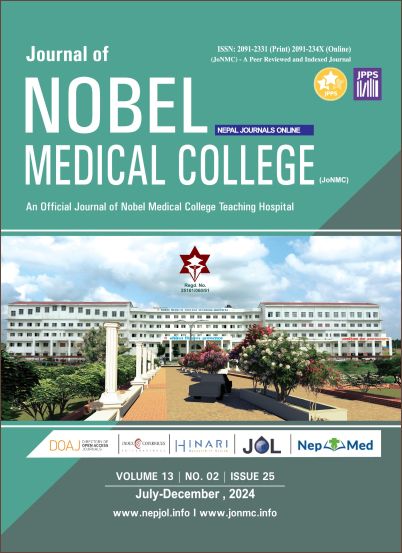Abdominal Sacro-Colpopexy Surgery for Vaginal Vault Prolapse at Nobel Medical College Teaching Hospital
DOI:
https://doi.org/10.3126/jonmc.v13i2.74461Keywords:
Abdominal sacrocolpopexy, Hysteropexy, Sacrocolpopexy, Vault prolapseAbstract
Background: Post-hysterectomy Vault prolapse is an uncommon late complication of hysterectomy. Women often experience restrictions in physical, emotional, and social functioning which decreases the overall quality of life. Vaginal vault prolapse can be treated by pelvic floor muscle training, pessary insertion, and surgery. Abdominal sacro-colpopexy is a procedure that surgically corrects vault prolapse using Prolene mesh to lift and hold the vaginal vault in the correct anatomical position. The study aimed to determine the success rate and complications of Abdominal sacro-colpopexy when performed by an experienced surgeon.
Materials and Methods: Observational descriptive study performed from June 2022 to December 2023 for 18 months at Nobel Medical College Teaching Hospital, Biratnagar, Nepal. All consecutive cases of vault prolapse surgeries were taken. Outcome measures were success rate and the potential complications post-operatively.
Results: The post-hysterectomy vault prolapse surgery was around 1% out of all gynecological surgeries. Most of them were asymptomatic in a median follow-up of 6 months. There were no complications of surgery. Almost all patients resolved their prolapse symptoms well, while none required further surgery.
Conclusion: Abdominal sacro-colpopexy is a safe and effective surgical method for post-hysterectomy vault prolapse.
Downloads
Downloads
Published
How to Cite
Issue
Section
License
Copyright (c) 2024 The Author(s)

This work is licensed under a Creative Commons Attribution 4.0 International License.
JoNMC applies the Creative Commons Attribution (CC BY) license to works we publish. Under this license, authors retain ownership of the copyright for their content, but they allow anyone to download, reuse, reprint, modify, distribute and/or copy the content as long as the original authors and source are cited.




